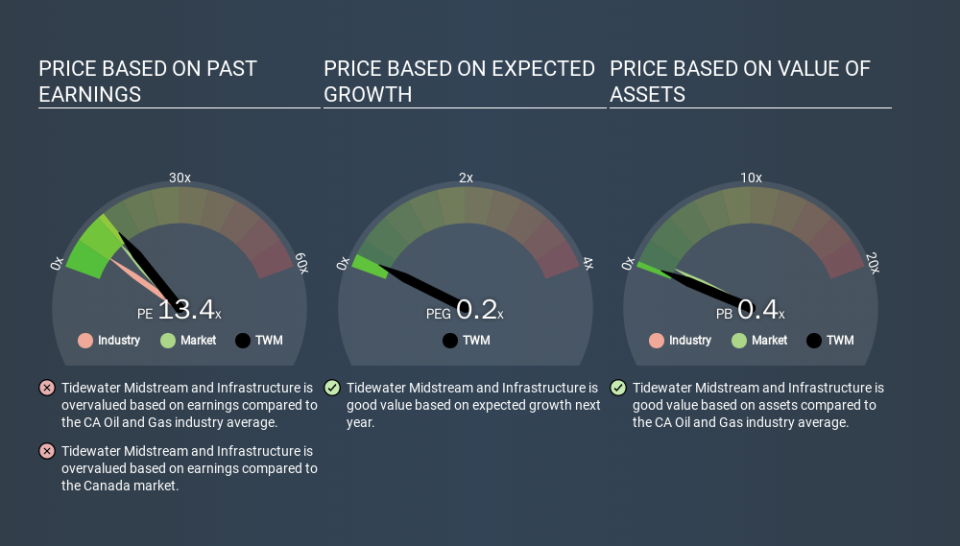How Does Tidewater Midstream and Infrastructure's (TSE:TWM) P/E Compare To Its Industry, After The Share Price Drop?

Unfortunately for some shareholders, the Tidewater Midstream and Infrastructure (TSE:TWM) share price has dived 49% in the last thirty days. And that drop will have no doubt have some shareholders concerned that the 61% share price decline, over the last year, has turned them into bagholders. For those wondering, a bagholder is someone who keeps holding a losing stock indefinitely, without taking the time to consider its prospects carefully, going forward.
Assuming nothing else has changed, a lower share price makes a stock more attractive to potential buyers. In the long term, share prices tend to follow earnings per share, but in the short term prices bounce around in response to short term factors (which are not always obvious). The implication here is that long term investors have an opportunity when expectations of a company are too low. One way to gauge market expectations of a stock is to look at its Price to Earnings Ratio (PE Ratio). Investors have optimistic expectations of companies with higher P/E ratios, compared to companies with lower P/E ratios.
View our latest analysis for Tidewater Midstream and Infrastructure
How Does Tidewater Midstream and Infrastructure's P/E Ratio Compare To Its Peers?
We can tell from its P/E ratio of 13.40 that there is some investor optimism about Tidewater Midstream and Infrastructure. As you can see below, Tidewater Midstream and Infrastructure has a higher P/E than the average company (6.6) in the oil and gas industry.
Its relatively high P/E ratio indicates that Tidewater Midstream and Infrastructure shareholders think it will perform better than other companies in its industry classification. The market is optimistic about the future, but that doesn't guarantee future growth. So investors should always consider the P/E ratio alongside other factors, such as whether company directors have been buying shares.
How Growth Rates Impact P/E Ratios
Companies that shrink earnings per share quickly will rapidly decrease the 'E' in the equation. That means even if the current P/E is low, it will increase over time if the share price stays flat. Then, a higher P/E might scare off shareholders, pushing the share price down.
In the last year, Tidewater Midstream and Infrastructure grew EPS like Taylor Swift grew her fan base back in 2010; the 73% gain was both fast and well deserved. Unfortunately, earnings per share are down 18% a year, over 5 years.
Remember: P/E Ratios Don't Consider The Balance Sheet
One drawback of using a P/E ratio is that it considers market capitalization, but not the balance sheet. In other words, it does not consider any debt or cash that the company may have on the balance sheet. The exact same company would hypothetically deserve a higher P/E ratio if it had a strong balance sheet, than if it had a weak one with lots of debt, because a cashed up company can spend on growth.
While growth expenditure doesn't always pay off, the point is that it is a good option to have; but one that the P/E ratio ignores.
Is Debt Impacting Tidewater Midstream and Infrastructure's P/E?
Net debt totals a substantial 289% of Tidewater Midstream and Infrastructure's market cap. This level of debt justifies a relatively low P/E, so remain cognizant of the debt, if you're comparing it to other stocks.
The Bottom Line On Tidewater Midstream and Infrastructure's P/E Ratio
Tidewater Midstream and Infrastructure's P/E is 13.4 which is above average (11.6) in its market. Its meaningful level of debt should warrant a lower P/E ratio, but the fast EPS growth is a positive. So it seems likely the market is overlooking the debt because of the fast earnings growth. Given Tidewater Midstream and Infrastructure's P/E ratio has declined from 26.0 to 13.4 in the last month, we know for sure that the market is significantly less confident about the business today, than it was back then. For those who prefer to invest with the flow of momentum, that might be a bad sign, but for a contrarian, it may signal opportunity.
Investors have an opportunity when market expectations about a stock are wrong. If the reality for a company is better than it expects, you can make money by buying and holding for the long term. So this free report on the analyst consensus forecasts could help you make a master move on this stock.
But note: Tidewater Midstream and Infrastructure may not be the best stock to buy. So take a peek at this free list of interesting companies with strong recent earnings growth (and a P/E ratio below 20).
If you spot an error that warrants correction, please contact the editor at editorial-team@simplywallst.com. This article by Simply Wall St is general in nature. It does not constitute a recommendation to buy or sell any stock, and does not take account of your objectives, or your financial situation. Simply Wall St has no position in the stocks mentioned.
We aim to bring you long-term focused research analysis driven by fundamental data. Note that our analysis may not factor in the latest price-sensitive company announcements or qualitative material. Thank you for reading.

